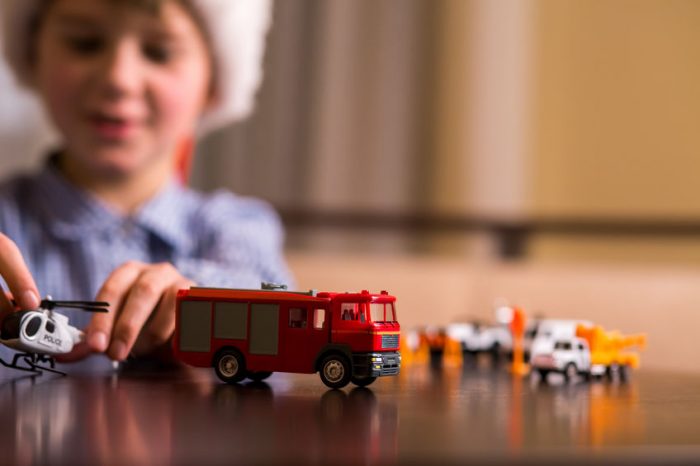
These days it seems there are thousands of options to keep children entertained. Technology has changed the way children look at having fun, but they can still cherish a real toy or two. As kids learn and grow, they will have an array of toys, some that may be unknowingly harmful to their health.
Some products your little ones are playing with might actually contain toxins that are, or in the future, will impact their health and growth. Being aware of what’s in your children’s toys is just as important as knowing what is in the food they eat, and if it goes unnoticed, can be even more harmful.
Lead
Lead is oftentimes thought to be a problem of the past, but it is in fact still prevalent and concerning for people of all ages, although children are more susceptible to the risks of lead poisoning. Despite the fact that lead has been banned in house paint and children’s toys nationwide since 1978, it is still utilized in other countries.
Because a large number of toys are made overseas, children can still be at risk for lead exposure. This chemical has the potential to harm their developing brains as well as the nervous system. When ingested, lead will travel to the brain, kidneys, and liver. The body will also store lead in the teeth and bones, allowing it to build up over time, later to be dispersed to other parts of the body. Dr Marcel Casavant, medical director of the Central Ohio Poison Center says, “It (lead) clearly hurts kids — and is fatal to kids in the United States about once or twice every 10 years.”
Several toys are still being made with lead, the most common issue being lead paint. This can be found in memory card toys, train sets, and even beloved Barbie dolls. This toxin is consumed through hand to mouth activity which means it’s even more important to keep a close eye on what your children are putting in their mouths.
In 2007, Mattel had to recall almost one million toys due to lead paint. Although risk of lead has decreased in recent years, it is something that still deserves attention. The symptoms of lead poisoning include irritability, loss of appetite, fatigue, vomiting, hearing loss, and even seizures. If you think your children might be at risk of lead exposure, do some research or visit your doctor. A blood test can be done to determine if lead is in the system and if so, how much.
Asbestos
Another toxin children may be exposed to is asbestos. It has been found in a wide range of kids products including crayons and crime scene kits. These products are known to contain talc, which is a binding ingredient in crayons and used as a powder substance for fingerprinting.
Although talc and asbestos are different, asbestos deposits can be found in talc mines and contaminate the products. When children color and continuously use crayons, they may potentially release asbestos into the air. When they use the crime scene kit and blow away the fingerprinting powder, they risk the chance of inhaling asbestos as well.
In a study done by scientific Analytical Institute, when they tested 28 boxes of crayons and 21 crime scene kits, all of which were made in China, four crayon brands and two crime scene kits contained traces of asbestos. That means around 14 percent of crayons contained a deadly toxin. These products were bought from major retailers as well as online, proving that it doesn’t matter where you purchase a product, there may always be a risk.
Asbestos is a known carcinogen, which means it is a substance that can promote the growth of cancer cells within the body. It can cause asbestosis, and is the only known cause of a rare cancer called mesothelioma . This cancer can be found in the lining of the lungs, heart, or abdomen. Because mesothelioma can take anywhere from 10-50 years to show symptoms after exposure, it can be difficult to diagnose, and difficult to treat.
Being aware of the products your children use can keep them healthy, and in this case save their lives. To know if your children’s products may contain asbestos, pay attention to where they were created, what brand it is, and what the toys are made of. Although not every crayon or crime scene kit contains asbestos, but being on the lookout could save a life.
What else to look out for
It is essential that your children have fun, but it’s more important that they are healthy and growing in the right direction. Lead and asbestos are just a couple of the toxins found in toys that are most prevalent today. There are others you should be keeping an eye out for too.
Phthalates are a group of chemicals that are used to soften and increase the flexibility of both plastic and vinyl. It hasn’t been allowed in products since 1999, but it is still worthwhile to stay vigilant about the products and brands you are bringing home. Phthalates can be found in teething rings, pacifiers, raincoats, and even the packaging of some foods and water bottles.
Talcum powder is also gaining attention in the news. It has been found that long time use of products such as baby powder, which includes talc, can lead to ovarian cancer. Although baby powder is of highest concern with talcum powder use, it can also be found in other products such as lip balm, deodorant, and has even been found in gum.
Children’s toys can help them learn, grow, and advance with age, but they can also have negative repercussions if the proper care and attention to product details is not given at the time of purchase. To make sure your children grow up to lead happy and healthy lives keep watchful eye on the products around them. Corporations still include harmful toxins and chemicals into their products regardless of the audience.
Emily Rosati is a Consumer Advocate focused on helping the public stay informed. Her ultimate goal is to educate and empower consumers to protect themselves from dangerous products being marketed and sold to the public.



